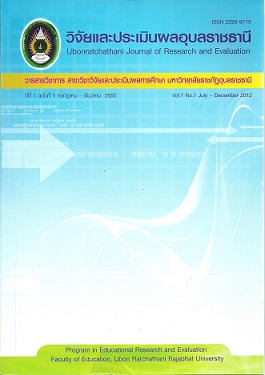A Development of Learning Achievement by using Cooperative Learning STAD in Physical of Mathayom Suksa Six Student of Nachaluay School of The Secondary Educational Service Area Office 29
Keywords:
A Development of Learning Achievement by using Cooperative Learning STAD, Action Research, PhysicsAbstract
The objectives of the research were to 1) develop the learning on atom physics by using the STAD cooperative learning management, 2) to compare the learning achievement before and after learning and 3) to compare the learning achievement of students who learned by STAD cooperative group learning management and of those who learned by a conventional learning method. The samples used in the study were 35 experimental group students and 35 control students, enrolled in the second semester of the school year 2010, of Nachaluay School under the jurisdiction of the Primary Education Educational Service Area 29. The subjects were derived by a group sampling. The research instruments were divided into two types: 1) the instrument used in the experiment:
9 lesson plans based on STAD and 9 lesson plans for a conventional learning management; 2) the instruments used to collect data were 1) the test on the learning achievement on atom physics, 2) the test at the end of the cycle, 3) the records of the teacher’s teaching method, 4) the records of students’ learning behavior, 5) the interview format, 6) the teacher’s daily records. Statistics used in the research were percentage, mean, standard deviation and t-test.
The research findings were as follows:
- Development of the learning on atom physics based on STAD cooperative learning management consisted of five steps: 1) introduction 2) sub-group learning 3) quiz 4) scores of individual students’ progress 5) the group that was recognized. A conventional learning management consisted of 3 steps: introduction, teaching and conclusion. Based on the operation, it was found that STAD cooperative learning encouraged students to work as a group, and help one another. It was found that slow learners would ask quick learners the questions about what they could not understand. Besides, a teacher’s personality also proved crucial for the classroom atmosphere. Students preferred the atmosphere favorable to learning. It was found that the students who learned by STAD cooperative learning management could improve their learning of physics.
- By comparing the learning achievement before and after learning of atom physics of Mattayomsuksa six (Grade 12) students, it was found that 82.85 of all students scored 50% which was the learning achievement mark. Students had a higher score of learning achievement with a statistical significance of .05.
- In comparing the learning achievement of those learning by STAD cooperative learning management and those learning by a conventional method, it was found that 82.85 % of the students who learned by STAD cooperative learning management secured the score to pass the set criterion, which was higher than 68.57 of the students who learned by a conventional method with a statistical significance of .05.
References
นงนุช ศุภวรรณ์ การพัฒนาแบบทดสอบวินิจฉัย เรื่อง ฟิสิกส์อะตอม 2 สำหรับนักเรียนชั้นมัธยมศึกษาปีที่ 6. วิทยานิพนธ์ศึกษาศาสตรมหาบัณฑิต มหาวิทยาลัยสงขลานครินทร์, 2547.
เนตรนภา เกียรติสมกิจ. การเปรียบเทียบผลการจัดการเรียนรู้วิชา เคมี เรื่องพันธะเคมี และความสามารถทางทักษะกระบวนการทางวิทยาศาสตร์ขั้นบูรณาการของนักเรียนชั้นมัธยมศึกษาปีที่ 4 ที่เรียนแบบร่วมมือโดยใช้เทคนิค STAD และเรียนด้วยวิธีปกติ. วิทยานิพนธ์ครุศาสตรมหาบัณฑิต มหาวิทยาลัยราชภัฏเทพสตรี, 2552.
ประนอม โพธิ์กัน. การเปรียบเทียบผลสัมฤทธิ์และเจตคติต่อการเรียนภาษาไทย เรื่องคำและหน้าที่ของคำ ของนักเรียนชั้นประถมศึกษาปีที่ 4 โดยใช้เทคนิค STAD กับการสอนแบบปกติ. วิทยานิพนธ์ครุศาสตร มหาบัณฑิต มหาวิทยาลัยราชภัฏเทพสตรี, 2550.
ลออ ปิ่นทอง. การเปรียบเทียบผลการเรียนรู้เรื่องหลักธรรมทางพระพุทธศาสนาของนักเรียนชั้นประถมศึกษา
ปีที่ 5 ที่เรียนโดยใช้วิธีสอนตามรูปแบบการสอนแบบกลุ่มร่วมมือกิจกรรม STAD กับวิธีสอนตามปกติ. วิทยานิพนธ์ครุศาสตรมหาบัณฑิต มหาวิทยาลัย ราชภัฏเทพสตรี, 2549.
สมคิด ภูสมดี. การพัฒนาแผนการจัดการเรียนรู้ด้วยเทคนิค STAD เรื่อง ระบบนิเวศ กลุ่มสาระการเรียนรู้วิทยาศาสตร์ ชั้นมัธยมศึกษาปีที่ 3. วิทยานิพนธ์การศึกษามหาบัณฑิต มหาวิทยาลัยมหาสารคาม, 2550.
อัญชนา โพธิพลากร. การพัฒนาชุดการเรียนคณิตศาสตร์ที่เน้นทักษะการแก้ปัญหาทางคณิตศาตร์ด้วยการร่วมมือ ชั้นมัธยมศึกษาปีที่ 3. วิทยานิพนธ์การศึกษามหาบัณฑิต มหาวิทยาลัยศรีนครินทรวิโรฒ, 2545.
Downloads
Published
How to Cite
Issue
Section
License
1. บทความที่ตีพิมพ์ในวารสารนี้ได้มีการตรวจสอบการลอกเลียนงานวรรณกรรมแล้ว ไม่เกินร้อยละ 25
2. บทความที่ตีพิมพ์ในวารสารนี้เป็นข้อคิดเห็น ข้อค้นพบของผู้เขียนบทความ โดยผู้เขียนบทความต้องเป็นผู้รับผิดชอบต่อผลทางกฎหมายใด ๆ ที่อาจเกิดขึ้นจากบทความนั้น ๆ
3. บทความ ข้อมูล เนื้อหา รูปภาพ ฯลฯ ที่ได้รับการตีพิมพ์ในวารสารวิจัยและประเมินผลอุบลราชธานี ถือเป็นลิขสิทธิ์ของวารสารวิจัยและประเมินผลอุบลราชธานี หากบุคคลหรือหน่วยงานใดต้องการนำทั้งหมดไปเผยแพร่ต่อหรือเพื่อกระทำการใดๆ จะต้องได้รับอนุญาตเป็นลายลักษณ์อักษรจากวารสารวิจัยและประเมินผลอุบลราชธานีก่อนเท่านั้น และจะต้องมีการอ้างอิงวารสารวิจัยและประเมินผลอุบลราชธานี ฉบับนั้น ๆ ด้วย






